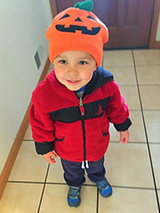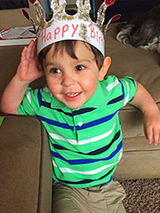Double Outlet Right Ventricle (DORV): Michael's Story
Double Outlet Right Ventricle (DORV): Michael's Story
Michael, 3, loves trucks and music, and sings with perfect pitch. He acts like a normal kid – running, climbing and wrestling – thanks to a series of heart surgeries at Children’s Hospital of Philadelphia to correct a rare heart defect.

Soon after his birth in Princeton, NJ, Michael was diagnosed with a rare heart defect: double outlet right ventricle (in which both great arteries are attached to the right ventricle) with pulmonary stenosis (a narrowing and thickening of the pulmonary valve). Within hours, he was transferred by helicopter to Children's Hospital of Philadelphia (CHOP).
Tara, Michael’s mother, remembers those first few hours. “At first they weren’t alarmed. Then, within a couple of minutes, I heard whispers. He was turning a little blue. They took him away. Finally, my OB came in and told me he was going to be transferred to CHOP. Before they took him for the flight, they let me sit with him for a few minutes. I held his hand and sang ‘When You Wish Upon a Star’ to him, knowing he would have to fight for his life the next few days away from my side.”
More About DORV
Learn about double outlet right ventricle (DORV), a defect where both major arteries are connected to the right ventricle, and how it’s treated at CHOP.
Intensive care and cardiac surgery as an infant
At CHOP, Michael was able to get the intensive pediatric cardiac care he needed. At ten days old, he was put on ECMO, a heart and lung bypass machine, to keep him alive until he was able to have the first of the several surgeries he would require.
The first procedure was done when he was 13 days old. William Gaynor, MD, placed a shunt to increase the flow of blood from Michael’s heart to his lungs. Four days later, Michael needed surgery again when an artery opened and started pumping blood into his chest cavity. Stephanie Fuller, MD, did the procedure in the Cardiac Intensive Care Unit, opening his chest and working on the artery to stop the bleeding.
“That was the worst day for me,” says Tara. “I had gone home to be with our older son. I got the call at 5:30 that Michael needed to be resuscitated, then another call that he would need emergency surgery. I drove right in. They handled it so quickly that I was still five minutes away from the hospital when his nurse called me to say he was stable.”
Michael was at CHOP for a month. He went home with a nasogastric (NG) tube for feeding, but no other special support was required. For the next year, he lived a relatively normal life.
Additional surgical repairs as a toddler
The next step in the surgical repair of Michael’s heart was the Rastelli procedure at 17 months of age to redirect the flow of oxygenated and depleted blood using a combination of patches and artificial conduits. Dr. Gaynor performed the operation, and as part of the procedure, also closed the hole between the lower chambers of Michael’s heart (the ventricular septal defect).
After recovery, Michael’s heart and lungs performed at a higher level to circulate oxygen to his body. The NG tube was removed, and Michael started eating for the first time, with help from a speech therapist.
When Michael was 2, his cardiologist, Sumekala Nadaraj, MBBS, noticed a change in his heart pressures during an echocardiogram. A cardiac catheterization found that there was an obstruction in his conduit causing these increased pressures. To correct the problem, Jonathan Rome, MD, Director of CHOP’s Cardiac Catheterization Laboratory, inserted a stent to help alleviate some of those pressures.
A truck driver with perfect pitch

Now 3, Michael is doing very well. He has hit the normal developmental milestones and tests in the high average range for key functions. He loves to run and climb, and enjoys wrestling with his older brother. He is fascinated by trucks, and has a motorized toy truck that he drives around the back yard every chance he gets.
Michael also loves music. “He is always singing,” says Tara. “And he has perfect pitch.”
There is one reminder of his medical history. When he plays with his stuffed animals, he often takes their vital signs.
Ongoing monitoring and support
Michael is enrolled in CHOP’s Cardiac Kids Developmental Follow-up Program. As a group, children with complex congenital heart disease (CHD) have a higher likelihood of experiencing problems related to neurodevelopmental issues compared to children without CHD.
The Cardiac Kids Developmental Follow-up Program was created to provide coordinated care for these children. The program provides screening, evaluation and coordinated care from a multidisciplinary team of experts that includes cardiologists, pediatricians, nurses, psychologists, social workers, and physical, speech and occupational therapists.
The program has helped Michael with feeding, when he was able to eat for the first time as a toddler. And it has helped him with physical and occupational therapy, building his strength before and after his surgeries.
“Michael's heart will never be ‘fixed,’” Tara explains. “He is monitored every few months by Dr. Nadaraj. She will let us know when he needs the next intervention. But now, as I see him acting like a normal kid, I have hope. Many people have told me when they are going through hard times, they find inspiration in Michael's story, and how he takes everything in stride. Almost everyone who encounters Michael falls in love with him. He is so charismatic.”
We’ve had so many people who have been so supportive. During a time when we felt like our world was spinning out of control, the doctors and nurses at CHOP have given us reassurance, security and hope. That’s the place to go for a miracle. They do perform miracles.